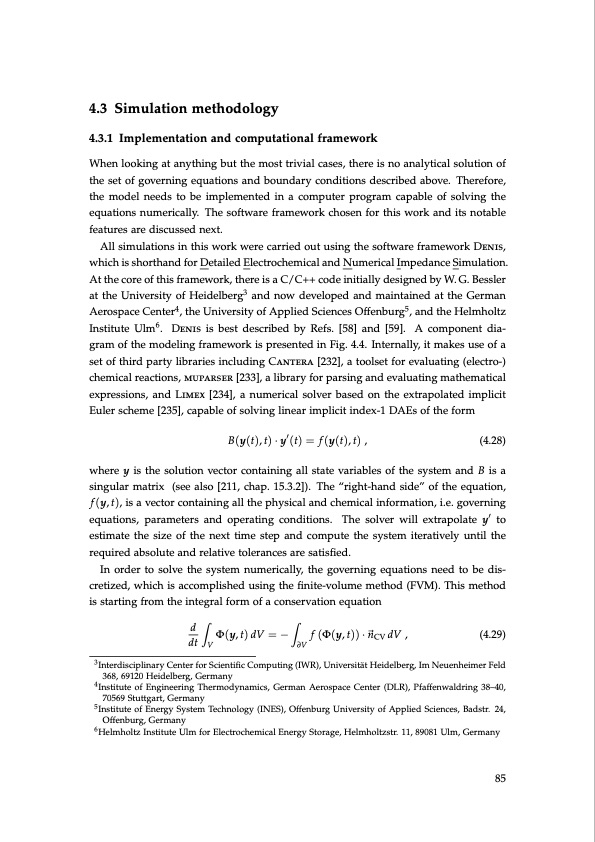
PDF Publication Title:
Text from PDF Page: 085
4.3 Simulation methodology 4.3.1 Implementation and computational framework When looking at anything but the most trivial cases, there is no analytical solution of the set of governing equations and boundary conditions described above. Therefore, the model needs to be implemented in a computer program capable of solving the equations numerically. The software framework chosen for this work and its notable features are discussed next. All simulations in this work were carried out using the software framework Denis, which is shorthand for Detailed Electrochemical and Numerical Impedance Simulation. At the core of this framework, there is a C/C++ code initially designed by W. G. Bessler at the University of Heidelberg3 and now developed and maintained at the German Aerospace Center4, the University of Applied Sciences Offenburg5, and the Helmholtz Institute Ulm6. Denis is best described by Refs. [58] and [59]. A component dia- gram of the modeling framework is presented in Fig. 4.4. Internally, it makes use of a set of third party libraries including Cantera [232], a toolset for evaluating (electro-) chemical reactions, muparser [233], a library for parsing and evaluating mathematical expressions, and Limex [234], a numerical solver based on the extrapolated implicit Euler scheme [235], capable of solving linear implicit index-1 DAEs of the form B(y(t), t) · y′ (t) = f (y(t), t) , (4.28) where y is the solution vector containing all state variables of the system and B is a singular matrix (see also [211, chap. 15.3.2]). The “right-hand side” of the equation, f (y, t), is a vector containing all the physical and chemical information, i.e. governing equations, parameters and operating conditions. The solver will extrapolate y′ to estimate the size of the next time step and compute the system iteratively until the required absolute and relative tolerances are satisfied. In order to solve the system numerically, the governing equations need to be dis- cretized, which is accomplished using the finite-volume method (FVM). This method is starting from the integral form of a conservation equation dˆˆ dt Φ(y,t)dV = − f (Φ(y,t))·⃗nCV dV , (4.29) V ∂V 3Interdisciplinary Center for Scientific Computing (IWR), Universität Heidelberg, Im Neuenheimer Feld 368, 69120 Heidelberg, Germany 4Institute of Engineering Thermodynamics, German Aerospace Center (DLR), Pfaffenwaldring 38–40, 70569 Stuttgart, Germany 5Institute of Energy System Technology (INES), Offenburg University of Applied Sciences, Badstr. 24, Offenburg, Germany 6Helmholtz Institute Ulm for Electrochemical Energy Storage, Helmholtzstr. 11, 89081 Ulm, Germany 85PDF Image | Lithium-Sulfur Battery: Design, Characterization, and Physically-based Modeling

PDF Search Title:
Lithium-Sulfur Battery: Design, Characterization, and Physically-based ModelingOriginal File Name Searched:
Dissertation_David_N._Fronczek_The_Lithium_Sulfur_Battery.pdfDIY PDF Search: Google It | Yahoo | Bing
Sulfur Deposition on Carbon Nanofibers using Supercritical CO2 Sulfur Deposition on Carbon Nanofibers using Supercritical CO2. Gamma sulfur also known as mother of pearl sulfur and nacreous sulfur... More Info
CO2 Organic Rankine Cycle Experimenter Platform The supercritical CO2 phase change system is both a heat pump and organic rankine cycle which can be used for those purposes and as a supercritical extractor for advanced subcritical and supercritical extraction technology. Uses include producing nanoparticles, precious metal CO2 extraction, lithium battery recycling, and other applications... More Info
| CONTACT TEL: 608-238-6001 Email: greg@infinityturbine.com | RSS | AMP |